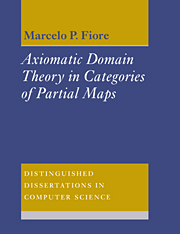Book contents
- Frontmatter
- Contents
- Preface
- 1 Introduction
- 2 Categorical Preliminaries
- 3 Partiality
- 4 Order-Enriched Categories of Partial Maps
- 5 Data Types
- 6 Recursive Types
- 7 Recursive Types in Cpo-Categories
- 8 FPC
- 9 Computational Soundness and Adequacy
- 10 Summary and Further Research
- A Lemma 8.4.4
- B Theorem 8.6.6
- C Lemma 9.1.3
- D Propositions D.0.1 and D.0.2
- Bibliography
- Index
- Symbol Index
7 - Recursive Types in Cpo-Categories
Published online by Cambridge University Press: 23 November 2009
- Frontmatter
- Contents
- Preface
- 1 Introduction
- 2 Categorical Preliminaries
- 3 Partiality
- 4 Order-Enriched Categories of Partial Maps
- 5 Data Types
- 6 Recursive Types
- 7 Recursive Types in Cpo-Categories
- 8 FPC
- 9 Computational Soundness and Adequacy
- 10 Summary and Further Research
- A Lemma 8.4.4
- B Theorem 8.6.6
- C Lemma 9.1.3
- D Propositions D.0.1 and D.0.2
- Bibliography
- Index
- Symbol Index
Summary
We investigate Cpo-algebraic completeness and compactness. This is a particularly well behaved setting. For example, we show that Cpo-algebraic completeness and parameterised Cpo-algebraic completeness coincide; whilst, for Cppo⊥-categories, we further show the coincidence of Cpo-algebraic completeness and parameterised Cpo-algebraic compactness. As a by-product, we identify a 2-category of kinds, called Kind, all of whose objects are parameterised Cpo-algebraically ω-compact categories. Kind is 2-cartesian-closed, op-closed, closed under the formation of categories of algebras and coalgebras with lax homomorphisms, and has a unique (up to isomorphism) uniform fixed-point operator. Thus, Kind is appropriate for interpreting type systems with kinds built by recursion from products, exponentials, algebras and coalgebras; but neither such a system nor its interpretation will be discussed here.
Cpo-Algebraic Completeness
Cpo-algebraic completeness is studied. First, we focus on those Cpo-categories for which the initial object embeds in every object of the category. The reason being that in this case the presence of colimits of ω-chains of embeddings guarantees algebraic ω-completeness which turns out to coincide with algebraic completeness. Further, an equational characterisation of initial algebras becomes available. Second, we explore categories of algebras and lax homomorphisms to finally show that algebraic completeness and parameterised algebraic completeness coincide.
Definition 7.1.1 In a Poset-category, an e-initial object is an initial object such that every morphism with it as source is an embedding. The dual notion is called a p-terminal object. An object which is both e-initial and p-terminal is called an ep-zero.
- Type
- Chapter
- Information
- Axiomatic Domain Theory in Categories of Partial Maps , pp. 133 - 146Publisher: Cambridge University PressPrint publication year: 1996



